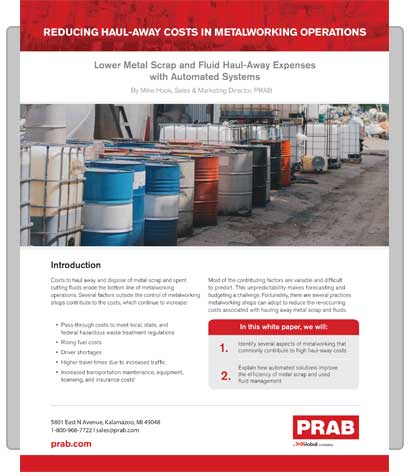
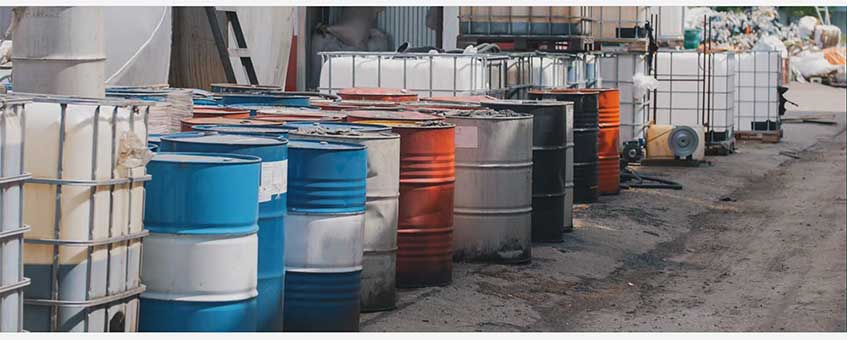
Costs to haul away and dispose of metal scrap and spent cutting fluids erode the bottom line of metalworking operations. Several factors outside the control of metalworking shops contribute to the costs, which continue to increase:
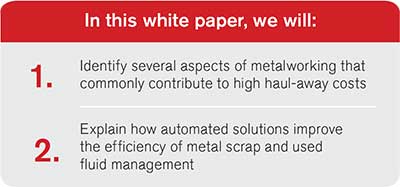
Most of the contributing factors are variable and difficult to predict. This unpredictability makes forecasting and budgeting a challenge. Fortunately, there are several practices metalworking shops can adopt to reduce the re-occurring costs associated with hauling away metal scrap and fluids.

There is little that metalworking operations can do to control costs associated with the logistics of waste removal. However, many metal scrap and fluid haul-away costs are formed long before a contract hauler pulls up to the shop. Here are three of the most common instances of higher-than-necessary haul-away costs that originate within the metalworking process.
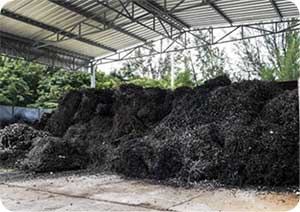
Unprocessed metal scrap comes in many forms: bushy material, die-cast scrap, metal chips, turnings, and swarf. The unwieldy shapes and sizes of the metal scrap combine to produce a mass of material that is typically low density, high volume, or (if coated with cutting fluid) heavy. The larger the volume of metal waste is, the more metal scrap there is to haul. The more volume there is to haul, the higher the costs will be.
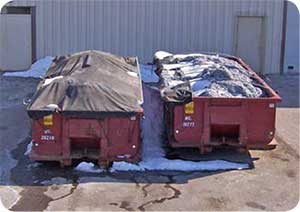
Optimizing the use of space in containers is important for both a metalworking company and its metal scrap recycler. Unprocessed scrap metal is usually extremely asymmetrical and doesn’t lend itself to orderly placement within a container, resulting in pockets of unused space. Furthermore, some load-out systems do not distribute the scrap evenly within the container. In either scenario, inefficient use of container space results in lower returns and more pick-ups from the hauler.
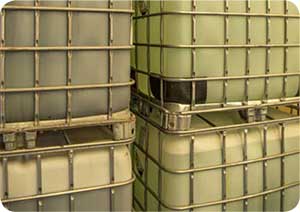
Used metalworking fluids and oils are regulated under the Resource Conservation and Recovery Act2. Diluted metalworking fluid mixtures contain about 5 to 20 percent fluid concentrate and 80 to 95 percent water by volume3. When fluid becomes contaminated with tramp oils, metal fines, and bacteria, proper hazardous waste disposal procedures that meet local, state, and federal standards must be met. The more stringent your area’s regulations, the higher the disposal costs are likely to be, with some costs estimated at $1,100 to dispose of 150 gallons of coolant.
To determine how much your metalworking operation is spending to haul away and dispose of metal scrap and fluids, track expenses each month and run a monthly report to review:
To reduce haul-away costs, metalworking operations need to:
Metal scrap processing and fluid filtration systems significantly lower haul-away costs through lower metal scrap and/or fluid waste volumes. By producing dry and more compact metal scrap, metal scrap processing systems also enable shops to garner a higher value for their metal scrap. Furthermore, fluid filtration will extend the life of cutting fluids—reducing new cutting fluid purchases up to 75%.
When it comes to transporting metal scrap, making the most of the space inside containers will reduce the total number of haul-away trips. Metal-scrap load-out systems designed to reach hard-to-fill areas of containers are able to utilize the most space inside containers through even distribution of the metal scrap. This yields a higher volume of metal scrap that is hauled away per trip, which results in fewer trips overall.
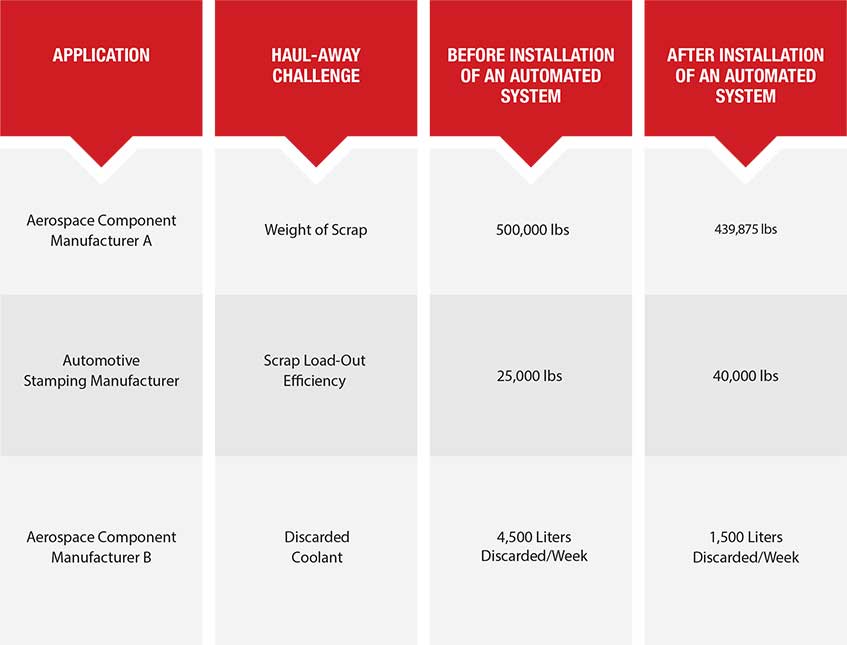
Actual haul-away cost savings will depend on each application’s unique needs. Nevertheless, there are many modular and centralized systems available to serve the needs of small shops and large manufacturers.
Reduce small to medium volumes of turnings and bushy wads to flowable metal chips and separate chips from fluid for increased value of machining scrap and cutting fluid. Systems are proven to reduce metal scrap volume by as much as 90%.
Compress loose turnings and swarf into near-solid dry pucks that are easy to re-melt, transport, and store. Because 99% of all hazardous and non-hazardous fluid is removed, the risk of fire is significantly reduced.
Heavy-duty chip and fluid separation system creates dry chips and reclaims up to 99% of cutting fluid using more than 600G’s of centrifugal force. Significantly reduces haul-away costs and increases scrap value.
Reduce metal turnings and bulky wads into shovel-grade chips for an overall reduction of scrap volume that is
6:1. System is proven to reduce scrap volume up to 90%.
Reduce turnings volumes up to 4 times at the source by shredding metal turnings into flowable chips. Shredders create small shovel-grade chips and increase value of metal scrap.
Achieve continuous low volume metal scrap reduction at the source, proven to reduce metal turning volume up to 12 times, resulting in lower transportation costs.
Remove liquid from filter cake to reduce volume and lower material disposal costs.
Reduces waste fluids up to 90% by removing tramp oils and suspended solids from contaminated coolant, controlling bacteria, and adjusting fluid concentration for fluid recovery.
Automates final load-out of stamping scrap, die scrap, and machining scrap into large trailers or railcars to maximum container fill. In-feed conveyor, and continuous back and forth operation provide even distribution into larger scrap containers.
There are many financial advantages to creating efficiencies in haul-away procedures. Metalworking operations that take steps to lower their haul-away costs through automated metal scrap processing, fluid filtration, and load-out systems will reduce their overhead expenses. They will also decrease their exposure to rising transportation costs, setting a foundation for more predictable budget forecasting. Finally, shops will also boost their bottom line through increased metal scrap value and extended fluid life.

Mike Hook is the Sales & Marketing Director for PRAB and has more than 15 years of mechanical design and application experience. PRAB is a leading manufacturer of engineered conveyors and equipment for processing turnings, chips, and metalworking fluids. PRAB also designs and builds industrial wastewater recycling systems.
1 Patrick Burnson, “2019 Rate Outlook: Pressure Builds,” Logistics Management, Jan. 10, 2019 – https://www.logisticsmgmt.com/article/2019_rate_outlook_pressure_builds
2 U.S. Environmental Protection Agency – https://www.epa.gov/hw/reference-table-question-what-used-oil
3 Carbide Processors Inc. – http://www.carbideprocessors.com/pages/machine-coolant/machine-coolant-water-quality.html
PRAB is a leading engineer and manufacturer of conveyors and chip and fluid management systems. Its customized solutions automate metal handling, reduce labor costs, reclaim and recycle expensive cutting fluids/coolants, and maximize return on recycling metals. With its expertise honed by more than 4,500 installations for the world’s leading OEMs and suppliers, PRAB continuously improves material handling, housekeeping, and compliance to environmental rules and regulations within the automotive, aerospace, medical, electronics, defense, off-road, and energy markets. For more information about PRAB, visit prab.com.